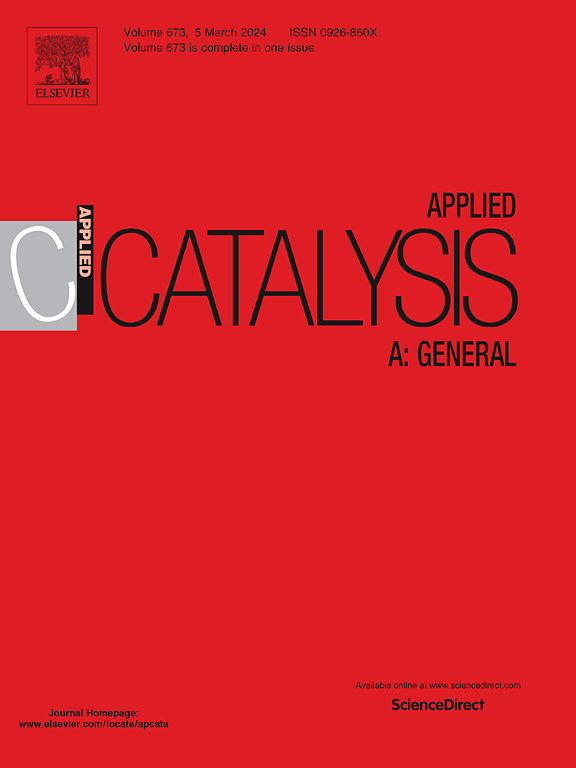Propylene oxidation to acrolein over Au@MoOx/MoO3 nanobelts driven by oxidative strong metal-support interactions
IF 4.8
2区 化学
Q2 CHEMISTRY, PHYSICAL
引用次数: 0
Abstract
Supported Au catalysts are widely investigated for selective oxidation processes. Here, propylene oxidation was studied over Au nanoparticles supported on MoO3 nanobelts. Intriguingly, the Au particles were encapsulated by MoOx layers in oxidizing atmospheres yielding Au@MoOx aggregates which signal non-classical oxidative strong metal-support interaction (SMSI) between Au and MoO3. The core@shell particles enhanced the acrolein selectivity of MoO3 from 18 % up to 81 % while its formation rate accelerated more than twentyfold to 1153 µmol gcat−1 h−1 at 3 wt% Au loading and 350 °C. In situ CO DRIFTS measurements, H2-TPR and XPS analyses suggest that the Au@MoOx entities facilitate the transfer of MoO3 lattice oxygen to propylene in line with the Mars-van Krevelen mechanism for acrolein formation. Apparent activation energies in the 113–163 kJ mol−1 range point to re-oxidation of the ensuing oxygen-deficient MoOx moieties as rate-limiting acrolein formation step. Consequently, the oxidative SMSI strongly promotes propylene conversion to acrolein over MoO3-supported Au catalysts.
在Au@MoOx/MoO3纳米带上由氧化强金属-负载相互作用驱动的丙烯氧化成丙烯醛
负载型金催化剂在选择性氧化过程中得到了广泛的研究。本文研究了MoO3纳米带负载的Au纳米颗粒对丙烯的氧化作用。有趣的是,Au粒子在氧化气氛中被MoOx层包裹,产生Au@MoOx聚集体,这标志着Au和MoO3之间的非经典氧化强金属支撑相互作用(SMSI)。core@shell粒子将MoO3的丙烯醛选择性从18 %提高到81 %,而在3 wt% Au负载和350°C条件下,MoO3的形成速率提高了20倍以上,达到1153µmol gcat−1 h−1。原位CO DRIFTS测量、H2-TPR和XPS分析表明,Au@MoOx实体促进MoO3晶格氧向丙烯的转移,符合丙烯醛形成的Mars-van Krevelen机制。在113-163 kJ mol−1范围内的表观活化能指向随后的缺氧MoOx部分作为限速丙烯醛形成步骤的再氧化。因此,氧化SMSI在moo3负载的Au催化剂上强烈促进丙烯转化为丙烯醛。
本文章由计算机程序翻译,如有差异,请以英文原文为准。
求助全文
约1分钟内获得全文
求助全文
来源期刊

Applied Catalysis A: General
化学-环境科学
CiteScore
9.00
自引率
5.50%
发文量
415
审稿时长
24 days
期刊介绍:
Applied Catalysis A: General publishes original papers on all aspects of catalysis of basic and practical interest to chemical scientists in both industrial and academic fields, with an emphasis onnew understanding of catalysts and catalytic reactions, new catalytic materials, new techniques, and new processes, especially those that have potential practical implications.
Papers that report results of a thorough study or optimization of systems or processes that are well understood, widely studied, or minor variations of known ones are discouraged. Authors should include statements in a separate section "Justification for Publication" of how the manuscript fits the scope of the journal in the cover letter to the editors. Submissions without such justification will be rejected without review.
 求助内容:
求助内容: 应助结果提醒方式:
应助结果提醒方式:


